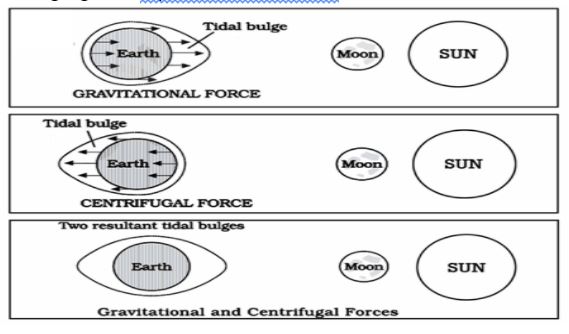GS 1, Indian Geography, TLP-UPSC Mains Answer Writing
1. What are tides? How do tides form? Explain. What is the significance of tides for marine ecology? Discuss.
ज्वार क्या हैं? ज्वार कैसे बनता है? समझाएं। समुद्री पारिस्थितिकी के लिए ज्वार का क्या महत्व है? चर्चा करें।
Demand of the question:
It expects candidates to write about the tides and mechanism of their formation. It also expects to write how tides play an important role in marine ecology.
Introduction:
Tides are the periodic rise and fall of the oceans water level, once or twice a day, caused by the combined effects of the gravitational forces exerted by the sun, the moon and the rotation of the earth.
Body:
Formation of tides:
- Combined effects of the gravitational forces exerted by the Moon and the Sun and the rotation of Earth cause occurrence of tides in oceans.
- Hence, the mechanism of tides formation could be understood by understanding the gravitational force of the Sun and the Moon.
- These bodies experience the gravitational pull over each other depending upon their mass and the distance between them.
- Since the Sun is far away from the Earth as compared to the Moon. Hence, the Sun’s gravitational pull is lesser over the Earth than the moon. Thus, the moon determines the magnitude of the tide.
- It is supposed that only the water bodies are pulled by the gravitational pull, however, it is not the fact.
- It is both the land and water bodies that get pulled by the gravitation. Since the relative pull of the land is less in comparison to that of water, the effect of gravitation on the water bodies is more.
- Following Figure 1 represents mechanism of tide formation.

Figure 1
Significance of tide for marine ecology:
- Marine ecology is the study of living things in the ocean and how they interact with their environment.
- Sustenance of life: Tides affect various aspects of oceanic life, including the reproductive activities of fish and ocean plants. Floating plants and animals ride the tidal currents between the breeding areas and deeper waters.
- Source of habitat and food: Sea creatures like Crabs, mussels, snails, seaweed etc. inhabit the tidal zone and the most important point to be remembering that without the regular washing of the tides, these complex and abundant creatures would die and food resources would diminish.
- Moderate temperature: The tides and tidal currents mix arctic water that can’t absorb sunlight when compared with warmer tropic water that does. Tides stir the ocean water that makes habitable climatic condition and help in maintaining the temperatures around marine ecological habitat.
- Tides removes pollutants and circulate nutrients required for survival of ocean plants and animals. e.g. Seawater in and out of tidal bays and estuaries.
- Tides play vital role for the growth and formation of mangroves, its canopy and formation of zone in the mangrove ecosystem and associated diversity.
- Tides also help to maintain mudflats that provide habitation for flora and fauna.
Conclusion:
In this way tides play an important role by contributing for sustenance of vital life processes around the marine ecology and helps to conserve the rich biodiversity of the marine ecology of planet earth.













